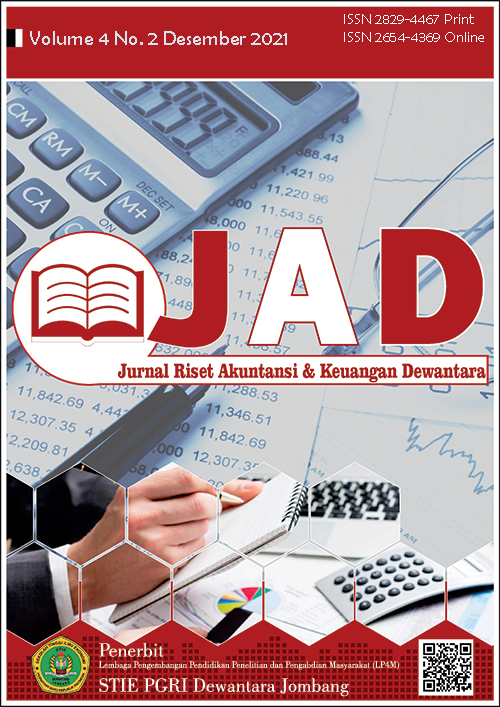PERLAKUAN AKUNTANSI UNTUK HERITAGE ASSET PADA PENINGGALAN PURBAKALA
 Abstract views: 499
,
Abstract views: 499
,
 PDF (BAHASA INDONESIA) downloads: 1982
PDF (BAHASA INDONESIA) downloads: 1982
Abstract
This study aims to assess the accounting treatment for heritage assets at the Mojokerto Cultural Heritage Preservation Center. This study used a qualitative approach. The data used was primary data obtained through in-depth interviews with informants. In addition, secondary data in the form of financial reports were also used to complete the research. The analysis tool used source triangulation. The results showed that the management of historical assets at the Mojokerto Cultural Heritage Preservation Center was in accordance with the Government Accounting Standard Guidelines 07, which was recognized after a letter of determination from the authorities was issued. Although the valuation of historic assets was still having difficulty determining the method that was in accordance with Government Accounting Standard Guidelines 07, namely historical assets were valued at zero and disclosed in the Notes to Financial Statements without value by only stating the number of units of the historic asset and only recording the price of the fee for the discovery of historical objects at the registration section at the Mojokerto Cultural Conservation Preservation Center
References
AASB. (2014). Statement of Accounting Concepts .
Achadiyah, B. N. (2017). Perlakuan Akuntansi Untuk Aset Bersejarah†Candi Rimbi†Jombang. Nominal: Barometer Riset Akuntansi dan Manajemen, 29-47.
Agustini, A. T., & Hendrawan, S. P. (2011). Aset Bersejarah Dalam Pelaporan Keuangan Entitas Pemerintah. Jurnal Ekonomi Akuntansi dan Manajemen, 10-21.
APB. (2000). Accounting Principal Board (APB) Statement. London.
Broadbent, J., & James, G. (2008). Public sector to public services: 20 years of “contextualâ€. accounting research." Accounting, Auditing & Accountability Journal, 234-250.
FASB. (2009). Financial Reporting Statement (FRS) Heritage Assets. Accounting Standads Board United Kingdom. Wosinten DC.
Febriansyah, R. A. (2020). Perlakuan Akuntansi Untuk Aset Bersejarah (Studi Fenomenologi Pada Candi Prambanan). Jurnal Akuntnasi: Trasparansi dan Akuntanbilitas, 11-18.
IAI. (2015). Standar Akuntansi Keuangan. Jakarta.
IAS. (2014). nternational Financial Reporting Standards. Wosinten DC.
IASC. (2012). Generally Recognised Accounting Practice Departement National Treasury. New York.
IPSAS. (2015). Heritage and Community Asstes: Measurement of Heritage and Community Assets.
Jim, C. Y. (2014). Evaluation of heritage trees for conservation and management in Guangzhou city (China). Environmental management, 74-86.
McGee, R. (2011). Is it unethical to evade taxes in an evil or corrupt state? A look at Jewish, Christian, Muslim, Mormon and Baha'i perspectives. A Look at Jewish, Christian, Muslim, Mormon and Baha'I Perspectives, 345-3671.
Romão, X., Esmeralda, P., & Nuno, P. (2016). A framework for the simplified risk analysis of cultural heritage assets. Journal of Cultural Heritage, 696-708.
Ruslin, R., & Endang, T. P. (2021). Perlakuan Akuntansi Terhadap Aset BERSEJARAH (Studi Fenomenologi pada Mesjid Agung Keraton Buton). ENTRIES, 131-148.
Safitri, M. R., & Mirna, I. (2017). Praktik akuntansi untuk aset bersejarah studi fenomenologi pada Museum Aceh. Jurnal Ilmiah Mahasiswa Ekonomi Akuntansi (JIMEKA), 1-9.
Sahar, W. S. (2020). Perlakuan Akuntansi Untuk Aset Bersejarah: Pengakuan, Penilaian Dan Pengungkapannya Dalam Laporan Keuangan (Studi Kasus Pada Museum Wisma Karya Kabupaten Subang). Prisma (Platform Riset Mahasiswa Akuntansi), 82-94.
Authors who publish with this journal agree to the following terms:
- Copyright on any article is retained by the author(s).
- The author grants the journal, right of first publication with the work simultaneously licensed under a Creative Commons Attribution License that allows others to share the work with an acknowledgment of the work’s authorship and initial publication in this journal.
- Authors are able to enter into separate, additional contractual arrangements for the non-exclusive distribution of the journal’s published version of the work (e.g., post it to an institutional repository or publish it in a book), with an acknowledgment of its initial publication in this journal.
- Authors are permitted and encouraged to post their work online (e.g., in institutional repositories or on their website) prior to and during the submission process, as it can lead to productive exchanges, as well as earlier and greater citation of published work.
- The article and any associated published material is distributed under the Creative Commons Attribution-ShareAlike 4.0 International License





